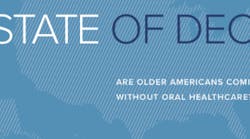Oral Health America releases report analyzing state-by-state dental care of older adults
Oral Health America (OHA) published a national report examining factors impacting the oral health of older adults. With more than 72 million seniors living in the United States by 2030, OHA's AState of Decay, Vol. IV, illustrates progress in some areas and the need for continued action to ensure America's rapidly growing population of seniors age healthily and independently.
Top report findings include:
- One-third (33%) of older adults have lost six or more teeth
- 25 U.S. states received a poor overall score based on six key performance measures
- Minnesota, Wisconsin, Iowa, Connecticut and Colorado all earned an "Excellent" Composite Score. Iowa and California made big improvements, jumping from 23rd and 30th, respectively, in 2016 to third and ninth in 2018
- The states with the lowest overall scores are Wyoming, Delaware, West Virginia, New Jersey, Arkansas, Texas, Oklahoma, Louisiana and Tennessee, with Mississippi's score being the least favorable. Alabama improved from 50th in 2016 to 29th in 2018
- Community water fluoridation (CWF) increased to a state average of 73%, a national increase of about 2.2 million people
- Medicaid coverage of oral health benefits increased
- Sociodemographic factors, such as income, race, gender and education play a critical role in oral health outcomes
--------------------------------------------------
Dental professionals can download a copy of the report by clicking here.
--------------------------------------------------
Interview
RDH Editor Mark Hartley talks with Oral Health America CEO and President Beth Truett about the 2018 State of Decay report.
--------------------------------------------------
A State of Decay, Vol. IV gives a rating of "Poor," "Fair," "Good," or "Excellent" based on state-level data analyzing six variables impacting older adult oral health:
- Severe tooth loss (loss of 6+ teeth)
- Dental visits
- Adult Medicaid dental benefits
- Community water fluoridation
- State oral health plans
- Basic screening surveys
For the first time, A State of Decay, Vol IV adds a national analysis of the Centers for Disease Control and Prevention's (CDC) individual data on severe tooth loss and recent dental visits by considering associations with sociodemographic factors.
"With half of the United States receiving a 'fair' or 'poor' rating relative to meeting minimal standards for the oral health of older adults, we must identify and address the steps needed to ensure the health of our burgeoning senior population," said Beth Truett, President and CEO of Oral Health America. "As depicted in this report, even with improvements by certain states, millions of older adults are still at a disadvantage when it comes to oral health care. Access to and utilization of care and to the coverage needed to pay for care is critical to increasing the overall health and wellness of America's seniors."
Federal and state policies are needed to address the underlying, systemic variables that prohibit older adults from achieving good oral health outcomes. A State of Decay, Vol. IV recommends the following to promote healthy aging and independence for this rapidly growing cohort of America's population:
- Reinstate, establish or maintain a comprehensive adult Medicaid dental benefit.
- Integrate comprehensive dental coverage in Medicare.
- Sustain or expand community water fluoridation.
- Include specific objectives for older adults in all State Oral Health Plans (SOHP).
- Conduct Basic Screening Surveys (BSS) of older adults in all states.
A State of Decay, Vol. IV is the fourth in a series of reports from OHA surveying the state of oral health for older Americans. Visit www.oralhealthamerica.org.
Editor's note: This article was originally posted on April 17. It was updated on April 25 to include the video interview.







